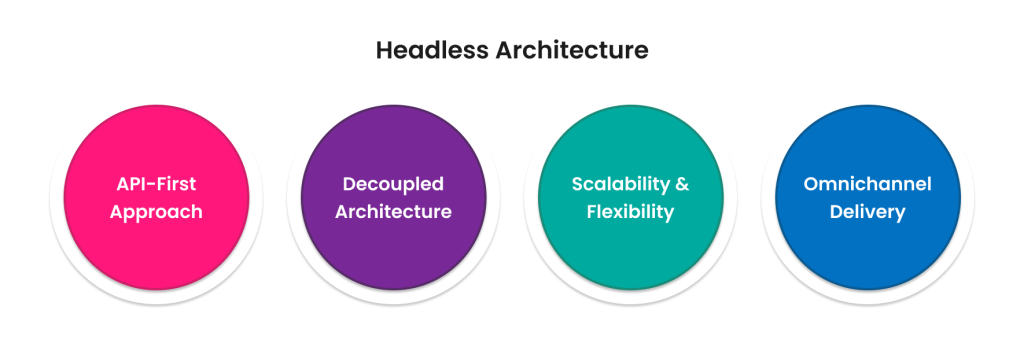
As a service provider to B2B SaaS & Digital Native businesses, we have been observing headless architecture or API-first SaaS platforms gaining a lot of traction. Unlike traditional SaaS, which integrates both layers tightly, headless SaaS platforms empower businesses to deliver tailored experiences across multiple platforms while streamlining development and reducing dependency on monolithic architectures.

This fits well with API Economy as well where businesses are consuming services as APIs. Businesses like Stripe, Auth0, Twilio were some of the earlier adoptors and many other appeared in the e-Commerce space soon including Strapi, Contentful & Shopify. Due to e-commerce, logistics has certainly seen emergence of many a headless platforms.
Drivers
Needless to say, this is the result of a phenomenon in modern software solutions at the end of the enterprises, who are usually the customers for these platforms. I would sum up that phenomenon in form of an ask to SaaS platforms “How do you seamlessly integrate with existing customer data to enhance the user experience?”. The enterprise IT teams are looking to optimize their efforts & cost by composing solutions on top of and across existing enterprise systems & SaaS platforms they procure. There are several compelling reasons behind this that address both developer and business needs.
Business Needs –
- Flexibility & Omnichannel Delivery – In an era where users interact with brands across various channels (mobile apps, web, voice assistants, smart devices), headless systems enable seamless content and functionality delivery to any platform via APIs.
- Modular Approach – The ability to integrate third-party services via APIs provides a modular approach, making it easier to plug in specialized tools without rebuilding core functionality. This allows businesses to conceptualize automated workflows across systems and get rid of information silos within each system.
- Faster Adaptation to New Technologies – With the rise of new devices and interaction channels, headless architecture allows companies to easily extend their systems to support these without the need for a complete overhaul.
- Faster Time-to-Market – With pre-built APIs and separation of layers, development teams can work on both simultaneously, speeding up the overall development process and reducing time-to-market for new features or products.
Developer Needs –
- Decoupled Frontend and Backend – Headless architecture separates the backend functionality from the frontend user interface. This allows developers to be in-charge of the user experience they want to serve their users. Developers are free to use any modern frontend frameworks without being constrained by the backend, leading to more innovation and creativity.
- Pre-built APIs – Many headless platforms provide pre-built APIs that handle complex backend functionality, allowing frontend developers to focus on the user interface and interaction, accelerating deployment.
- Scalability and Performance – A headless architecture reduces the infrastructure complexity & maintenance costs and a simplified architecture makies it easier to handle traffic spikes or scale specific features.
- Adaptability to Modern Development Practices – The headless approach aligns with the shift toward microservices architecture, where each service can be developed, deployed, and scaled independently.It fits well with the API-first economy, where businesses are building and consuming services via APIs.
- Future-Proofing – Headless systems are more adaptable to future changes in technology. As new frontend frameworks or devices emerge, only the frontend needs to be updated, while the backend remains stable.
- Better Separation of Concerns – With headless architecture, the backend is less exposed to the public since it only communicates with the frontend via APIs. This separation adds a layer of security, minimizing vulnerabilities and attack surfaces.
- Tight Control Over Data Access – API-driven communication allows for fine-grained control over which data is accessed and how, reducing the risk of data breaches.
Challenges
Headless architecture provides the flexibility, scalability, and agility that modern software solutions demand, making it an ideal choice for platforms that need to support integration & data exchange with enterprise systems. At the same time, it poses some challenges as well for the businesses.
- Higher initial cost – Although headless SaaS can lead to a reduced Total Cost of Ownership (TCO) over time, the initial implementation and ongoing maintenance costs can be higher than traditional models. Organizations may need to invest in additional resources, including hiring specialized developers who are proficient in both front-end and back-end technologies.
- Complexity of Implementation – With more inter-dependent systems, Integration Overhead surfaces as coordination between multiple services and APIs can become cumbersome.
- Potential for Vendor Lock-in – With a deeper integration to your own systems, it becomes harder to swap out a SaaS platform as there may be dependency on specific API structures or proprietary technologies.
Trends & Future
Headless architectures have shown the way for Composable Architecture and businesses are more and more moving towards combining multiple headless SaaS services to form best-of-breed solutions to provide unique experiences to customers. The amount of startups who are leveraging OpenBanking and Analytics SaaS ecosystem to provide new services to customers is increasing everyday.
These architectures have also catalyzed the growth of low-code-no-code tools and as a result, enabled non developers to work with APIs to get off the ground quickly. There is an increasing adoption of SaaS due to headless architectures in traditionally slower-moving industries like healthcare, finance etc.
As we look to the future, the evolution of headless SaaS platforms is poised to reshape the digital landscape significantly. With increasing demands for flexibility and personalization, businesses are expected to adopt headless architectures at an accelerated pace, leveraging API-driven solutions to create seamless omnichannel experiences. The integration of advanced technologies such as artificial intelligence and machine learning will further enhance the capabilities of headless systems, enabling organizations to harness data more effectively and deliver hyper-personalized content.
Moreover, as companies continue to prioritize agility in their operations, the trend towards adopting best-of breed solutions will likely grow, allowing for greater customization and innovation. While challenges remain in terms of implementation and security, the overall trajectory points towards a future where headless SaaS becomes a standard approach for organizations striving to stay competitive in an increasingly dynamic market. Embracing headless architecture not only prepares businesses for current trends but also positions them for future advancements in technology and customer expectations.
Written By: Anurag Setia








